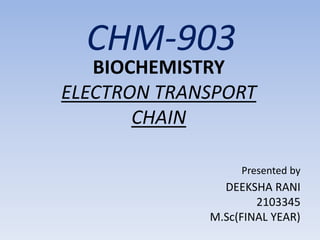
ELECTRON TRANSPORT CHAIN
- 1. CHM-903 BIOCHEMISTRY ELECTRON TRANSPORT CHAIN Presented by DEEKSHA RANI 2103345 M.Sc(FINAL YEAR)
- 2. In eukaryotes => Electron transport and oxidative phosphorylation => inner mitochondrial membrane. These processes => re-oxidize NADH and FADH2 <= from the citric acid cycle (mitochondrial matrix ), glycolysis (cytoplasm ) and fatty acid oxidation ( mitochondrial matrix) and => trap the energy released as ATP. Oxidative phosphorylation => major source of ATP in the cell. In prokaryotes => electron transport and oxidative phosphorylation components => in the plasma membrane.
- 3. Oxidation => loss of electrons. Reduction => gain of electrons. In chemical reaction : if one molecule is oxidized => another must be reduced i.e. oxidation-reduction reaction => transfer of electrons.
- 4. when NADH => oxidized to NAD+ => it loses electrons. When molecular oxygen => reduced to water => it gains electrons :
- 5. ATP is the energy currency of the cell and is used to power a variety of cellular reactions Biosynthesis of macromolecules (e.g. polymer assembly ) Emission of light (e.g. bioluminescence Movement (e.g. muscle contraction) Active transport (e.g. endocytosis / exocytosis) Nerve transmission (e.g. propagation of action potentials) Growth and repair (e.g. mitotic division) Biochemical processes that utilize ATP include
- 7. Step 1: Generating a Proton Motive Force The hydrogen carriers (NADH and FADH2) are oxidised and release high energy electrons and protons The electrons are transferred to the electron transport chain, which consists of several transmembrane carrier proteins As electrons pass through the chain, they lose energy – which is used by the chain to pump protons (H+ ions) from the matrix The accumulation of H+ ions within the intermembrane space creates an electrochemical gradient (or a proton motive force)
- 8. Step Two: ATP Synthesis The proton motive force will cause H+ ions to move down their electrochemical gradient and diffuse back into matrix. This diffusion of protons is called chemiosmosis and is facilitated by the transmembrane enzyme ATP synthase As the H+ ions move through ATP synthase they trigger the molecular rotation of the enzyme, synthesising ATP
- 9. Step Three: Reduction of Oxygen In order for the electron transport chain to continue functioning, the de-energised electrons must be removed Oxygen acts as the final electron acceptor, removing the de- energised electrons to prevent the chain from becoming blocked Oxygen also binds with free protons in the matrix to form water – removing matrix protons maintains the hydrogen gradient In the absence of oxygen, hydrogen carriers cannot transfer energised electrons to the chain and ATP production is halted
- 10. The electron transport chain is a set of four protein compl exes Complex 1- NADH-Q oxidoreduc tase Q and Complex 2- Succinate- Q reductase Complex 3- Cytochrome c reductase Complex 4- Cytochrom e c oxidase
- 11. Complex 1- NADH-Q oxidoreductase: It comprises enzymes consisting of iron-sulfur and FMN. Here two electrons are carried out to the first complex aboard NADH. FMN is derived from vitamin B2.
- 12. • Q and Complex 2- Succinate-Q reductase: FADH2 that is not passed through complex 1 is received directly from complex 2. The first and the second complexes are connected to a third complex through compound ubiquinone (Q). The Q molecule is soluble in water and moves freely in the hydrophobic core of the membrane. In this phase, an electron is delivered directly to the electron protein chain. The number of ATP obtained at this stage is directly proportional to the number of protons that are pumped across the inner membrane of the mitochondria.
- 13. • Complex 3- Cytochrome c reductase: The third complex is comprised of Fe-S protein, Cytochrome b, and Cytochrome c proteins. Cytochrome proteins consist of the heme group. Complex 3 is responsible for pumping protons across the membrane. It also passes electrons to the cytochrome c where it is transported to the 4th complex of enzymes and proteins. Here, Q is the electron donor and Cytochrome C is the electron acceptor.
- 14. • Complex 4- Cytochrome c oxidase: The 4th complex is comprised of cytochrome c, a and a3. There are two heme groups where each of them is present in cytochromes c and a3. The cytochromes are responsible for holding oxygen molecule between copper and iron until the oxygen content is reduced completely. In this phase, the reduced oxygen picks two hydrogen ions from the surrounding environment to make water.
- 15. Summary Hydrogen carriers donate high energy electrons to the electron transport chain (located on the cristae) As the electrons move through the chain they lose energy, which is transferred to the electron carriers within the chain The electron carriers use this energy to pump hydrogen ions from the matrix and into the intermembrane space The accumulation of H+ ions in the intermembrane space creates an electrochemical gradient (or a proton motive force) H+ ions return to the matrix via the transmembrane enzyme ATP synthase (this diffusion of ions is called chemiosmosis) As the ions pass through ATP synthase they trigger a phosphorylation reaction which produces ATP (from ADP + Pi) The de-energised electrons are removed from the chain by oxygen, allowing new high energy electrons to enter the chain Oxygen also binds matrix protons to form water – this maintains the hydrogen gradient by removing H+ ions from the matrix